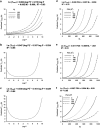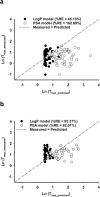Physicochemical properties of dietary phytochemicals can predict their passive absorption in the human small intestine
- PMID: 28512322
- PMCID: PMC5434065
- DOI: 10.1038/s41598-017-01888-w
Physicochemical properties of dietary phytochemicals can predict their passive absorption in the human small intestine
Abstract
A diet high in phytochemical-rich plant foods is associated with reducing the risk of chronic diseases such as cardiovascular and neurodegenerative diseases, obesity, diabetes and cancer. Oxidative stress and inflammation (OSI) is the common component underlying these chronic diseases. Whilst the positive health effects of phytochemicals and their metabolites have been demonstrated to regulate OSI, the timing and absorption for best effect is not well understood. We developed a model to predict the time to achieve maximal plasma concentration (Tmax) of phytochemicals in fruits and vegetables. We used a training dataset containing 67 dietary phytochemicals from 31 clinical studies to develop the model and validated the model using three independent datasets comprising a total of 108 dietary phytochemicals and 98 pharmaceutical compounds. The developed model based on dietary intake forms and the physicochemical properties lipophilicity and molecular mass accurately predicts Tmax of dietary phytochemicals and pharmaceutical compounds over a broad range of chemical classes. This is the first direct model to predict Tmax of dietary phytochemicals in the human body. The model informs the clinical dosing frequency for optimising uptake and sustained presence of dietary phytochemicals in circulation, to maximise their bio-efficacy for positively affect human health and managing OSI in chronic diseases.
Conflict of interest statement
The authors declare that they have no competing interests.
Figures




Similar articles
-
Statistical modelling coupled with LC-MS analysis to predict human upper intestinal absorption of phytochemical mixtures.Food Chem. 2018 Apr 15;245:353-363. doi: 10.1016/j.foodchem.2017.10.102. Epub 2017 Oct 20. Food Chem. 2018. PMID: 29287381
-
Pharmacokinetic properties of phytochemicals in Hypericum perforatum influence efficacy of regulating oxidative stress.Phytomedicine. 2019 Jun;59:152763. doi: 10.1016/j.phymed.2018.11.023. Epub 2018 Nov 19. Phytomedicine. 2019. PMID: 31004882
-
A model for the role of the proline-linked pentose-phosphate pathway in phenolic phytochemical bio-synthesis and mechanism of action for human health and environmental applications.Asia Pac J Clin Nutr. 2004;13(1):1-24. Asia Pac J Clin Nutr. 2004. PMID: 15003910 Review.
-
A review of dietary phytochemicals and their relation to oxidative stress and human diseases.Chemosphere. 2021 May;271:129499. doi: 10.1016/j.chemosphere.2020.129499. Epub 2021 Jan 4. Chemosphere. 2021. PMID: 33445014 Review.
-
Characterising absorption and health-related properties of phytochemicals extracted from Malaysian palm fruit biomass after oil extraction.Food Funct. 2020 Jan 29;11(1):907-920. doi: 10.1039/c9fo01149h. Food Funct. 2020. PMID: 31942898
Cited by
-
Encapsulated Phytomedicines against Cancer: Overcoming the "Valley of Death".Pharmaceutics. 2023 Mar 23;15(4):1038. doi: 10.3390/pharmaceutics15041038. Pharmaceutics. 2023. PMID: 37111524 Free PMC article.
-
Therapeutic and Preventive Potential of Plant-Derived Antioxidant Nutraceuticals.Foods. 2025 May 14;14(10):1749. doi: 10.3390/foods14101749. Foods. 2025. PMID: 40428528 Free PMC article. Review.
-
Mechanism-Driven and Clinically Focused Development of Botanical Foods as Multitarget Anticancer Medicine: Collective Perspectives and Insights from Preclinical Studies, IND Applications and Early-Phase Clinical Trials.Cancers (Basel). 2023 Jan 23;15(3):701. doi: 10.3390/cancers15030701. Cancers (Basel). 2023. PMID: 36765659 Free PMC article. Review.
-
Chronic Consumption of Cranberries (Vaccinium macrocarpon) for 12 Weeks Improves Episodic Memory and Regional Brain Perfusion in Healthy Older Adults: A Randomised, Placebo-Controlled, Parallel-Groups Feasibility Study.Front Nutr. 2022 May 19;9:849902. doi: 10.3389/fnut.2022.849902. eCollection 2022. Front Nutr. 2022. PMID: 35662954 Free PMC article.
-
Surface engineering of 3D-printed polylactic acid scaffolds with polydopamine and 4-methoxycinnamic acid-chitosan nanoparticles for bone regeneration.Nanoscale Adv. 2025 Jan 20;7(6):1636-1649. doi: 10.1039/d4na00768a. eCollection 2025 Mar 11. Nanoscale Adv. 2025. PMID: 39886612 Free PMC article.
References
-
- Global status report on noncommunicable diseases. (World Health Organisation, Geneva; 2014).
-
- D’Onofrio, G. et al. Phytochemicals in the treatment of Alzheimer’s disease: a systematic review. Curr. Drug Targets (2016). - PubMed
-
- Jarzab, A. & Kukula-Koch, W. Recent advances in obesity: the role of turmeric tuber and its metabolites in the prophylaxis and therapeutical strategies. Curr. Med. Chem (2016). - PubMed
-
- Stravodimos, G. A. et al. Phytogenic polyphenols as glycogen phosphorylase inhibitors: the potential of triterpenes and flavonoids for glycaemic control in type 2 diabetes. Curr. Med. Chem (2016). - PubMed
Publication types
MeSH terms
Substances
LinkOut - more resources
Full Text Sources
Other Literature Sources

